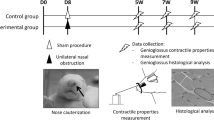Abstract
The morphological changes in rat facial muscles were evaluated after permanent denervation and were compared with findings after immediate reinnervation. Thirty rats underwent transection of the left and right facial nerves immediately followed by hypoglossal-facial nerve anastomosis on the right side (muscular reinnervation) and removal of 8–10 mm of the facial plexus on the left side (permanent muscular denervation). Levator labii muscle samples of both sides were collected sequentially at 2, 6, 7, 10, 20, and 24 weeks after surgery and submitted to routine histological and enzyme histochemical staining procedures. In normal levator labii muscles a typical “chessboard” pattern was found, with type I fibers being smaller than type II fibers. These latter fibers also were more prevalent than the type I fibers. Among the type II fiber subtypes, the type IIB fibers were larger and more frequent. Two weeks after surgery, there were no differences between denervated facial muscles and those undergoing reinnervation. Both showed atrophic myofibers among normal-sized fibers and slight fibrosis. Those muscles denervated for more than 2 weeks displayed increasing fiber atrophy with frequent loss of typability, as well as proliferation of connective tissue and fat cells in perimysial and endomysial sites. After denervation for 20 weeks only a few atrophic fibers were found in wide areas of fibrosis and fat cells. Following nerve anastomosis the reinnervated levator labii muscle showed much less fiber atrophy. Regrowth to normal fiber diameters was found with only a few atrophic myofibers 10 weeks after anastomosis although a moderate fibrosis predominated at perimysial sites. Reinnervated facial muscle fibers displayed a typical type-grouping pattern and also frequent lack of typability.
Similar content being viewed by others
References
Adams RD (1975) Diseases of muscle. A study in pathology, 3rd edn. Harper and Row, New York
Bajusz E (1964) “Red” skeletal muscle fibers: relative independence of neural control. Science 145:938–939
Bardosi A, Goebel HH, Stennert E (1987) The ultrastructure of normal and denervated human facial muscle. Plast Reconstr Surg 79:171–176
Belal A (1982) Structure of human muscle in facial paralysis. J Laryngol Otol 96:325–334
Blaivas M, Nelson CC (1991) Ultrastructural characteristics of human orbicularis oculi muscles at various stages. J Neuropathol Exp Neurol 50:351
Brooke MH (1973) The pathologic interpretation of muscle histochemistry. The striated muscle. William and Wilkins, Baltimore
Brooke MH, Engel WK (1969) The histographic analysis of human muscle biopsies with regard to fiber types. Diseases of the upper and the lower motor neuron. Neurology 19:378–393
Cohen MH, Lester JM, Bradley WG, Brenner JF, Hirsch RP, Silber DI, Ziegelmiller D (1987) A computer model of denervation-reinnervation in skeletal muscle. Muscle Nerve 10: 826–836
Dorman JD (1970) The histopathology neurogenic muscular atrophy. The striated muscle. William and Wilkins, Baltimore
Dubowitz V, Brooke MH (1985) Muscle biopsy: a clinical approach. Saunders, Philadelphia
Freilinger G, Happak W, Burggasser G, Gruber H (1990) Histochemical mapping and fiber size analysis of mimic muscles. Plast Reconstr Surg 86:422–428
Frey M, Happak W, Girsch W, Bittner R, Gruber H (1991) Histomorphometric studies in patients with facial palsy treated by functional muscle transplantation: new aspects for the surgical concept. Ann Plast Surg 26:370–379
Gavilan C, Gavilan J, Rashad M, Gavilan M (1988) Discriminant analysis in predicting prognosis of Bell's palsy. Acta Otolaryngol (Stockh) 106:276–280
Johnson MA, Polgar J, Weightman D, Appelton D (1973) Data on the distribution of fiber types in thirty-six human muscles. J Neurol Sci 18:111–129
Lexell J, Hendriksson-Larsen K, Sjöstrom M (1983) Distribution of different fiber types in human skeletal muscles. Acta Physiol Scand 117:115–122
May M, Sobol SM, Mester SJ (1991) Hypoglossal-facial nerve interpositional-jump graft for facial reanimation without tongue atrophy. Otolaryngol Head Neck Surg 104: 818–825
Neiss WF, Lichius OG, Angelov DN, Gunkel A, Stennert E (1992) The hypoglossal-facial anastomosis as model of neuronal plasticity in the rat. Ann Anat 174:419–433
Polgar J, Johnson MA, Weightman D, Appelton D (1973) Data on fiber size in thirty-six human muscles. J Neurol Sci 19: 307–318
Ringquist M (1973) Histochemical enzyme profiles of fibres in human masseter muscles with special regard to fibers with intermediate myofibrillar ATPase reaction. J Neurol Sci 18: 133–141
Ringquist M (1974) Size and distribution of histochemical fibre types in masseter muscles of adults with different states of occlusion. J Neurol Sci 22:429–438
Schwarting S, Schroeder M, Stennert E, Goebel HH (1982) Enzyme histochemical and histographic data on normal human facial muscles. ORL 44:51–59
Schwarting S, Schroeder M, Stennert E, Goebel HH (1984) Morphology of denervated human facial muscles. ORL 46: 248–256
Serratrice G, Pellissier JF, Vignon C, Barer J (1976) The histochemical profile of the human masseter. J Neurol Sci 30: 189–200
Smith IM, Heath JP, Murray JAM, Cull RE (1988) Idiopathic facial (Bell's) palsy: a clinical survey of prognostic factors. Clin Otolaryngol 13:17–23
Stennert E (1981) Bellsche Lähmung. Arch Otorhinolaryngol 231:134–177
Vignon C, Pellissier JF, Serratrice G (1980) Further histochemical studies on masticatory muscles. J Neurol Sci 45: 157–176
Author information
Authors and Affiliations
Rights and permissions
About this article
Cite this article
Tews, D.S., Goebel, H.H., Schneider, I. et al. Morphology of experimentally denervated and reinnervated rat facial muscle I. Histochemical and histological findings. Eur Arch Otorhinolaryngol 251, 36–40 (1994). https://doi.org/10.1007/BF00175955
Received:
Accepted:
Issue Date:
DOI: https://doi.org/10.1007/BF00175955




